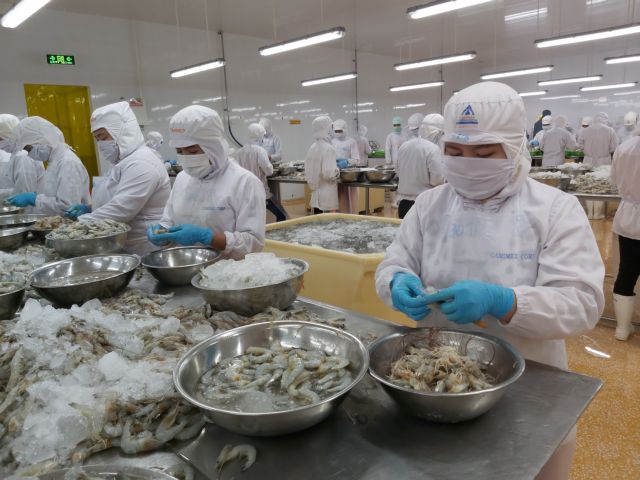 Economy
Economy

Seafood companies are struggling with problems arising from the current fourth wave of COVID-19, causing uncertainties for the second half of 2021. However the speed of vaccination and loosening of travel restrictions in many countries, especially the US, can support the industry.

|
| Camimex's employees remove shrimp shells at its processing plant. VNA/VNS Photo |
Ly Ly Cao
HÀ NỘI — Seafood companies are struggling with problems arising from the current fourth wave of COVID-19, causing uncertainties for the second half of 2021. However the speed of vaccination and loosening of travel restrictions in many countries, especially the US, can support the industry.
As southern provinces, which are hubs of the fishery industry, are hit hard by the ongoing outbreak, many seafood companies’ activities have been disrupted.
The pandemic broke out again right at the time to accelerate exports and farmers enter harvest season.
With the rising number of COVID-19 infections, the local government has carried out many measures to contain the disease, including a requirement for negative test certificates for freight drivers, or implementation of the stay-at-work model to maintain production.
The validity of the certificates depends on each province, some provinces for seven days, others for three. For example, Bạc Liêu requires that the test certificate must be obtained within 24 hours. The regulation on the validity of the certificate is not consistent among provinces, causing many difficulties and disruptions in transportation.
Many seafood companies have struggled to apply these measures, resulting in suspension of production.
“Seafood enterprises are straining to prevent the spread of COVID-19,” Nguyễn Hoài Nam, Deputy General Secretary of the Việt Nam Association of Seafood Exporters and Producers (VASEP), said at a conference to review the first six months and deploy tasks for the rest of the year launched by the Directorate of Fisheries under the Ministry of Agriculture and Rural Development, in Hà Nội in early June.
Currently, 16 out of 30 seafood processing enterprises in Tắc Cậu Fishing Port Industrial Park in Bình An commune, Châu Thành District, Kiên Giang Province, have temporarily suspended operations as they can’t ensure COVID-19 prevention.
Seafood processing factories are also faced with a labour shortage as workers infected are in quarantine areas, while some workers refused to come to work due to concerns over getting infected.
"This is a very tough time," Trương Đình Hoè, General Secretary of VASEP, said in a phone call with Việt Nam News.
"We are anxiously looking for solutions," he added.
Problem solving
To support enterprises amid this crisis, VASEP proposed a consensus between provinces and cities on a specific time for the COVID-19 negative test certificate, and to approve applying antigen tests, or rapid tests, instead of PCR tests. The rapid test can be performed at control points for the test certification that expires within 24 hours.
On July 29, the Office of the Government issued official letter No5187/VPCP-CN on facilitating the transportation of goods during the COVID-19 outbreak.
In addition, VASEP proposed to put freight drivers on the priority list for COVID-19 vaccination as early as July in all localities.
Regarding labour, companies need to ensure a safe environment to encourage workers to come back to processing plants such as adjusting production shifts, distancing production lines, measuring body temperature, wearing masks, and particularly, vaccinating employees.
At the end of July, the Ministry of Agriculture and Rural Development also launched an online conference on connecting supply and demand of livestock and aquaculture products amid the pandemic to ensure production and consumption, and link supply and demand of agricultural products between provinces and cities.
Positive business results in Q2
After a poor performance in the first quarter, some seafood firms recorded good results as big export destinations have controlled the pandemic.
In its second quarter financial statement, Vĩnh Hoàn Corporation (VHC) reported a slight gain of 5.3 per cent year-on-year in net revenue to nearly VNĐ1.4 trillion (US$59.8 million).
During the period, the leading company in exporting pangasius witnessed drops of 2.6 per cent and 62.4 per cent in cost of goods sold and expenses for financial activities, respectively.
This resulted in a rise of nearly 52 per cent in profit after tax to VNĐ146.5 billion. In the first quarter, its profit after tax fell 13.5 per cent over the year to VNĐ131.6 billion.
In the first half of 2021, the seafood exporter’s net revenue was VNĐ2.59 trillion, down slightly compared to the same period last year. But its profit after tax still posted a jump of 91 per cent to VNĐ308.9 billion.
Camimex Group JSC (CMX) also had good results in the second quarter with consolidated net revenue up 68.4 per cent to VNĐ718.1 billion. Its cost of good sold reached VNĐ653 billion, nearly two times higher than that of last year.
However the exporter’s profit after tax still rose 21 per cent to VNĐ21.6 billion.
In the first quarter, its profit after tax declined by 46 per cent year-on-year.
As of June 30, the company recorded a rise of 31 per cent and 16 per cent in net revenue and profit after tax, respectively.
Bullish outlook for the rest of the year
In June's seafood exports, Mirae Asset Securities (Việt Nam) still sees a bullish outlook for the industry in the rest of the year due to rising vaccinations in importing countries and Việt Nam, leading to the reopening of many important markets like Europe and the US.
Data compiled by the customs sector showed that the country’s seafood export turnover reached over $4.1 billion in the first six months of the year, up 14.6 per cent, while marine products' export turnover climbed 16 per cent to $1.6 billion.
However the securities firm warns that rising material costs and container shipping costs are other challenges for the industry, affecting business results.
In the first four months of 2021, the average price of raw pangasius increased by 11 per cent over the same period last year, while the price of white-leg shrimp jumped about 20 per cent.
Meanwhile, container shipping costs from Asia to other continents surged during the period, with the Shanghai - Los Angeles route up 238 per cent due to the shortage of ships and containers, which were affected by the pandemic.
On the stock market, Mirae Asset is also optimistic about seafood export stocks in the second half of this year. It assesses that the market prices of these stocks are likely to surpass previous peaks as the market benchmark VN-Index recently grounded at 1,300 points. —VNS

|




